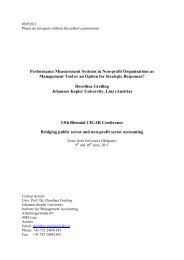A theoretical framework and classification of capability areas
A theoretical framework and classification of capability areas
A theoretical framework and classification of capability areas
Create successful ePaper yourself
Turn your PDF publications into a flip-book with our unique Google optimized e-Paper software.
5 Classification (RQ3)<br />
5.1 Exploratory <strong>classification</strong> by cluster analysis<br />
We applied trial-<strong>and</strong>-error to choose the algorithmic method <strong>and</strong> the number <strong>of</strong> clusters that best fit<br />
our data, by using SPSS (version 18). The independent variables were the 17 <strong>capability</strong> <strong>areas</strong>. Since<br />
they are binary (i.e. present or not), no st<strong>and</strong>ardisation was required.<br />
• First, all methods available in SPSS (version 18) were tried on the full dataset (N=69),<br />
resulting in four methods with clusters containing at least three BPMMs. Other methods with<br />
clusters containing one or two BPMMs are considered as less reliable, <strong>and</strong> thus omitted.<br />
• Next, to obtain stable results, these four methods were used on a split dataset, comprising<br />
only BPMMs for generic business processes (N=37). It makes abstraction <strong>of</strong> the specific<br />
process types included, i.e. supply chain or collaboration processes, to be applicable to any<br />
process type. All four methods, resulting from the previous step, showed similarity on the<br />
split dataset for two clusters. Since two clusters merely confirm the previous distinction<br />
between BPM maturity <strong>and</strong> BPO maturity, we opted for a refinement into more clusters to<br />
provide more information. This option resulted in two methods, each with three clusters, that<br />
stayed fairly similar on the split dataset: Ward’s method <strong>and</strong> k-means.<br />
The previous steps reduced our choice to two algorithmic methods (i.e. Ward <strong>and</strong> k-means) with three<br />
clusters. Both clustering solutions were further examined to evaluate which one best fits our data.<br />
• A Cohen’s Kappa value was computed as a measure <strong>of</strong> agreement on group memberships. A<br />
good agreement was found between both methods on the full dataset (kappa=0.4

















